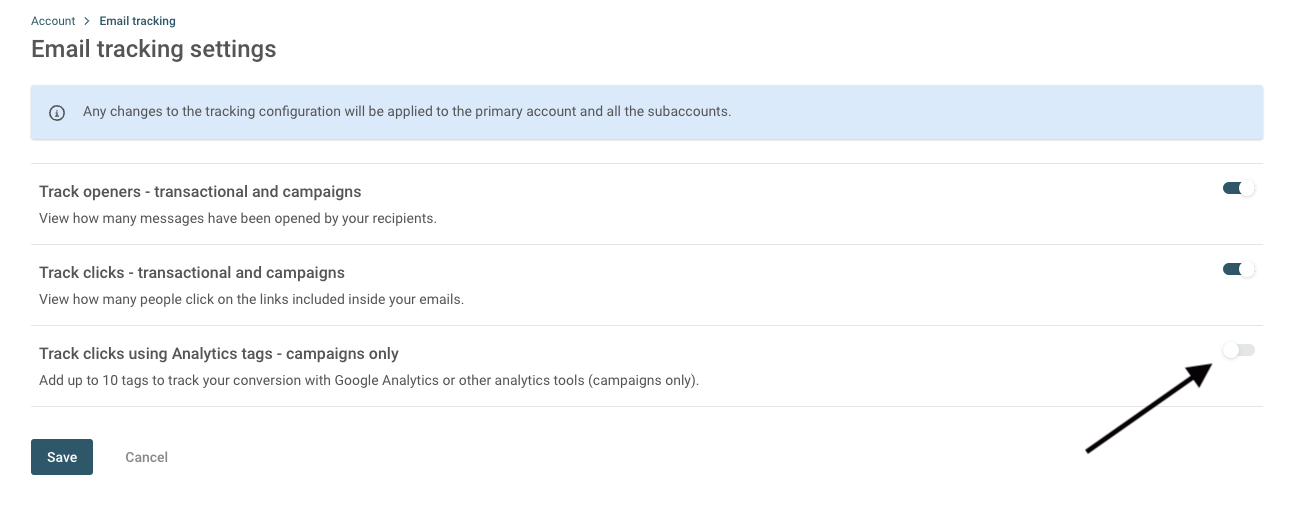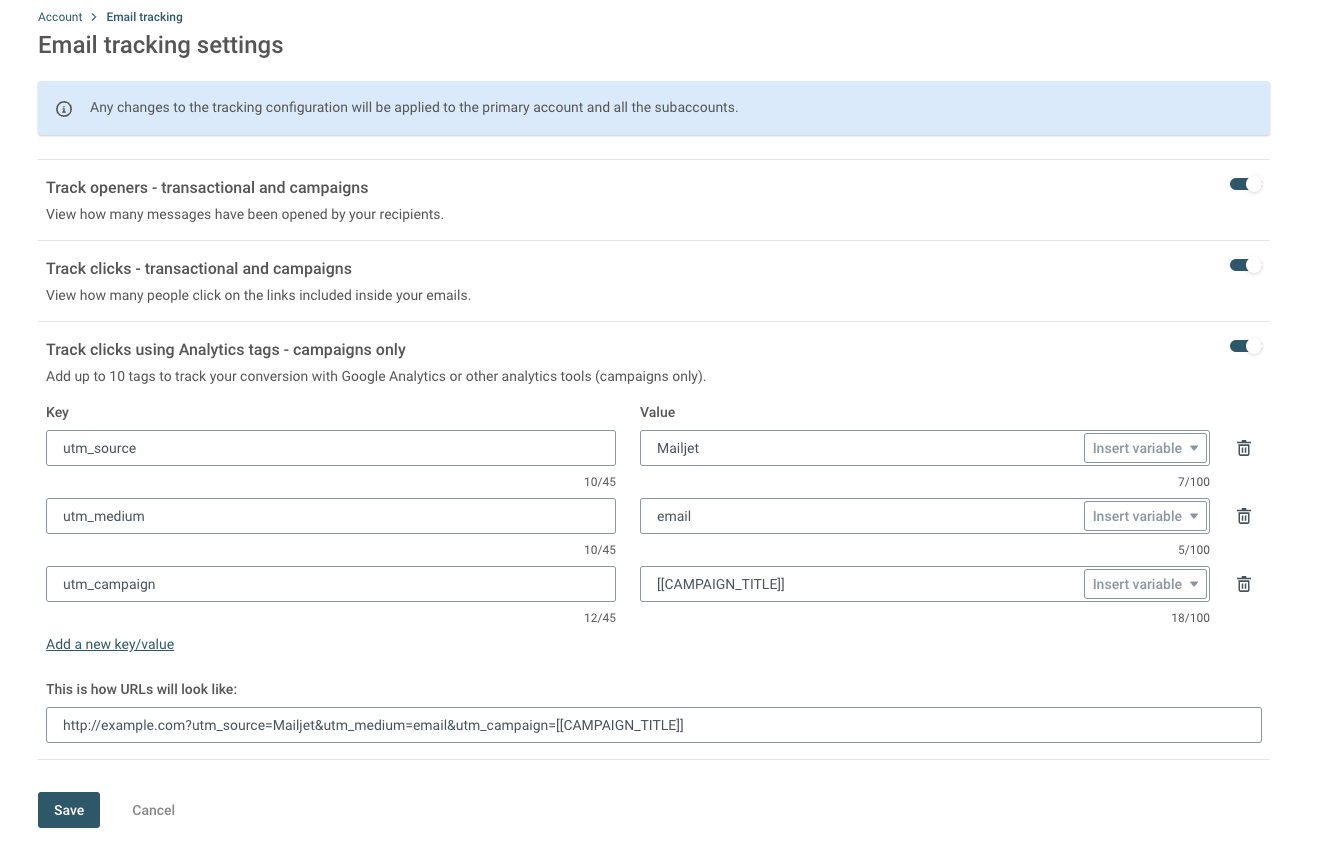Email best practices
Why you should use UTM tagging on your campaigns
Keeping track of your emailing stats is important. With UTM tagging, you can also know what was the journey of your readers through your website.

PUBLISHED ON
Data doesn’t lie. Tracking means optimizing and getting better results.
While we encourage you to set up and follow metrics, we also want you to be able to track them easily so you can consistently get great results. Because emailing doesn’t stop with pressing “send”. You want to know who opened your message and which CTAs generated the most clicks.
Thankfully, most email service providers (ESP’s) offer you those KPIs out the box, such as open, unsubscribe, click or bounce rates. However, what do you do if you’d like to go deeper? To know the exact path people took after clicking your newsletter CTA? Or which pages on your website they visited and what they purchased?
Well, we have a solution for you - UTM tagging.
Table of content
What is a UTM tag?
“UTM” stands for “Urchin tracking module” and is a snippet of code added to the end of a URL. These small bits of text, also known as UTM parameters, can then be read by your analytics tool (typically Google Analytics) to track the journey your visitors take across your website.
Pro tip: If you’d like a helping hand setting up your Google Analytics 4 account and tracking what happens after someone clicks through to your website, we recently wrote a piece on tracking email marketing with GA4. Go give it a read now or bookmark it for later.
What does a UTM parameter look like?
An example of a URL link enriched with utm parameters looks like this:
https://www.yourwebsite.com/yourpage/contentofthepage/?utm_source=weeklynewsletter&utm_medium=email&utm_campaign=promospring2020&utm_term=skincare&utm_content=logolink
In this URL, some parameters are mandatory and others optional:
source (mandatory): this describes where your traffic is coming from. For example, the name of an email campaign, Facebook or Google campaigns, etc.
medium (mandatory): this defines the type of medium of your source. For example, email, social media, organic, ads, etc.
campaign (mandatory): this helps you know exactly what campaign generated the traffic. Make sure you differentiate them well to track their unique performances.
term (optional): in case of paid search and/or referral, add “term” to better identify your performing keywords.
content (optional): if you have multiple links, or the same link included multiple times in your campaign, fill in this value to differentiate them. Example: logolink, CTAlink, headerlink, etc.
Why is UTM tagging important in email marketing?
You are already able to see your audience’s behavioral information thanks to our advanced statistics (sent, opened, clicked, bounced, etc.) so why add an extra layer with Analytics Tracking?
Well, wouldn’t it be nice to see what subscribers do after they open and click on your email? And, unless you’ve added UTM parameters to your campaign links (or applied some kind of magic we are not aware of yet), you won’t be able to.
UTM parameters help you track the effectiveness of your campaigns and observe your customers’ journey across your website. They can be used across almost all marketing channels: SEA ads, social ads, earned backlinks...and of course, email.
By effectively tracking traffic across your website, you can more accurately attribute ROI to the highest performing campaigns and channels. If you must make a change to your strategy, you’ll be able to use data to back up your decision.
The reason we use Mailjet for our newsletter is that we really like the drag and drop editor, it's straightforward, it's easy and intuitive to use and there's great campaign reporting and analytics. We also like the security of the platform and the deliverability.
Jordan Hollander CEO and Co-Founder, Hotel Tech Report
Common mistakes in setting up UTM tracking
If you’re new to the UTM tracking game there are some common pitfalls you’ll want to try and avoid when setting up your campaigns. We’ve listed a few of them below:
Inconsistent naming: This is a big one. UTM parameters rely on consistency to give you clean data, so an inconsistent use of spelling, capitalization, and abbreviations across campaigns (e.g., "Facebook" vs "FB") will fragment your data and make analysis difficult within GA4.
Not using UTMs for all links: Don't just track your main call to action (CTA). Tag every link in your email that leads somewhere outside the email itself to give yourself a more complete picture of user behavior.
Missing UTMs altogether: Don’t be lazy, now! Skipping them means flying blind on campaign performance.
Confusing source and medium: These parameters have distinct purposes. "Source" is the origin of the traffic (e.g., "email"), while "medium" is the marketing channel (e.g., "newsletter"). Mixing them up will skew your data.
Not testing UTMs: Before you hit send, make sure your UTM codes are working properly. There are tools available to help you test your URLs and ensure they're tracking data correctly.
UTM tracking for internal links: UTMs are meant for tracking external traffic. Using them for internal links within your website can inflate bounce rates and distort session data.
UTM link expert, Milena Mitova, delved into why tracking emails beyond the first click is paramount in maximizing campaign ROI in her Email Camp session.
How can you use UTM tagging with Mailjet?
To easily start tracking your email campaigns in your favorite analytics tool, there are a couple of simple steps you’ll need to follow:
Step 1: Make sure you are on a Premium plan and you are logged in with your master account. If you’re not on Premium yet… what are you waiting for?
Step 2: Go to your account by clicking on your initials on the top right corner and then select ‘Account Settings’ then 'Email tracking settings'. You can easily access that through this link too. Once there, you'll find a list of tracking options, including the latest addition: 'Analytics tags'. Click to enable it.

Step 3: Once it’s enabled, an additional section with parameters will appear.

We prefill the three first fields with default UTM tags that Google Analytics operates with, but you can change them if you use another system, delete and even add extra fields (up to a total of 10) to have optional parameters as well.
You’ll see two components for each UTM tag per row: “Key” and “Value”. If you want to use an UTM like “utm_campaign”, make sure it’s filled with [[CAMPAIGN_TITLE]] so everything runs automatically.
Feel free to personalize all the parameters depending on your needs and on the analytics tool you are using, so you create the optimal tracking for your streams.
Here is an example in which we have only included the prefilled sections:

Once you complete the fields and shape the structure of your UTM tag, hit “Save”. That’s it, you’re all set. Every link in every campaign sent will be automatically enriched with the UTM tags.
Start using UTM tags with Mailjet
Once enabled and configured, Analytics Tracking will be activated for your master account as well as all your sub-accounts! You’ll be able to follow your audience’s journey and improve your ROI by setting up Analytics Tracking for all your email marketing campaigns.
UTM tagging is only available on Premium plans, and only applicable for email campaigns: marketing campaigns, or transactional emails grouped as a campaign. To use it, you can sign up or upgrade to any Premium plan.
Want to boost your email strategy? Make sure you get the best engagement and ROI. Our premium features help you create incredible campaigns.
Related readings
Popular posts

Top email marketing trends for 2022
To the outsiders, it can sometimes feel like email hasn't changed that much since it was created. Maybe this is why some are so persistent in...
Read more

Reducing email’s carbon footprint
When it comes to protecting our planet, every step toward cleaner practices – small and big – counts. So, what if we told you that emailing, as clean and green as it seems...
Read more

Marketing calendar 2024: Dates you shouldn’t miss this year
We finally got through 2023 (phew!) and Q1 is just around the corner. It’s time for you to start scribbling down your New Year’s Resolutions to make sure we start the year with a bang. If you’ve found your way here, we’re guessing that’s because creating a winning...
Read more



